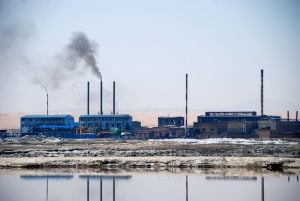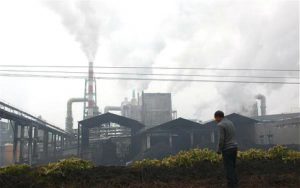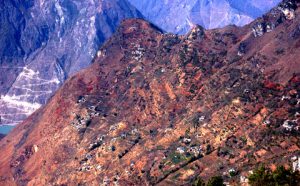It seems counter-intuitive that publicly available data needs grassroots activists to make it accessible. Yet, in a sea of regulations and information, official environmental information can be difficult to parse.
The risk of information overload looms especially large in China, whose rapidly growing economy makes transparent environmental monitoring increasingly urgent and difficult. For instance, is water pollution improving or declining over time? What does all of this mean for public health?
Without a way to find a signal through the noise, environmental data can become a smokescreen, rather than an indicator.
In an effort to solve this, two NGOs – the Natural Resources Defense Council (NRDC) and the Beijing-based Institute of Public and Environmental Affairs (IPE) – developed the groundbreaking Pollution Information Transparency Index (PITI) in 2009.
The Index ranks 120 Chinese cities on the transparency of their environmental monitoring and compliance information. Specifically, IPE and NRDC examine how well major urban areas stack up against four key metrics: the comprehensiveness, timeliness, integrity and user-friendliness of their data.
These four metrics, in turn, score eight different categories, covering specific issues like sewage discharge information requests and fees, as well as broader trends, such as government efforts to address environmental issues in specific sectors, regions or facilities. Three criteria – the daily pollution monitoring disclosure results, complaint and petition records and compliance with information-disclosure requests – weigh heavily in the final rankings, which score cities out of 100 points. A grade of 60 represents a “pass”, meaning a city meets the mandates of Chinese monitoring and disclosure laws. A score of 89.5 or higher marks a transparency “all-star”, a city that provides consistently transparent data across all eight categories.
To date, no city has reached “all-star” status and recent scoring adjustments make this goal even more difficult to achieve. Citing “severe pollution circumstances” and “groundbreaking improvements” in China’s information disclosure policies, NRDC and IPE have applied higher standards to this year’s evaluations, “causing a majority of cities to score considerably lower in this round of the assessment.” The city of Ningbo, which has claimed first place in every PITI since the index began in 2008, and achieved a score of 85.3 in 2013, received only 65.9 points in 2014.
However, some leaders have emerged. In the 2014 PITI, Beijing and the four eastern cities of Shanghai, Ningbo, Qingdao and Zhenjiang claimed the top five spots, while inland Datong, Yangquan, Yuxi, Jilin and Shaoguan finished last. The five top-scoring cities reflect a larger trend within the PITI; developed regions along the southeastern coast tend to perform well, while less developed inland regions do worse.
It’s important for the eastern seaboard to perform well, as it’s the most densely populated and industrialised region, with the highest emission discharges. However, IPE has “noticed a trend for the big polluters to migrate inland,” Ma Jun, the IPE’s director, said in a 2012 interview with the Yale Center for Environmental Law and Policy.
Industry’s migration reflects the disparity in resources and population across different parts of the country. The concentration of wealth and people in China’s eastern coastal cities give these areas greater capacity to regulate pollution. Less populated areas in China’s interior and western cities have a larger capacity to absorb pollution, but contain fragile ecosystems, including the sources of major rivers that can carry damages downstream. Furthermore, these areas may not stay sparsely populated for long. Economic growth in central and western China leads the country.
Despite these concerns, there has been progress. For instance, 23 provinces, autonomous regions and municipalities use integrated online platforms to release monitoring information, and “are increasingly well-placed to provide the data to drive discussions about environmental management.” This trend is most pronounced in developed areas, especially in Shandong, Zhejiang, Fujian, Jiangsu and Hebei provinces. Many inner Western provinces, including Inner Mongolia, Shaanxi, Xinjiang, Ningxia and Guangxi, have also made significant gains and “essentially achieved working order” with their online data platforms. In contrast, the first 2008 PITI report gave only seven mentions of cities with online platforms to share monitoring information publicly.
Recent legislative changes seem geared to support this turn towards online tools to bolster transparency as a means of ensuring environmental compliance. In April, amendments to China’s Environmental Protection Law instructed government departments to strengthen data-release mechanisms. These changes, the first in 25 years, include a new system for fining pollution violations and a performance-assessment system that considers officials’ environmental records alongside their economic ones.
When the law goes into effect on January 1, 2015, it will also give NGOs latitude “to take legal action against polluters on behalf of the public interest.” While environmental organisations note several gaps in the legal access this provides, the amendment still significantly expands the public’s ability to hold polluters accountable. The Ministry of Environmental Protection’s "Guidance Opinion on Promoting Public Participation in Environmental Protection" (Guidance Opinion), released in May 2014, encourages government agencies to ensure citizens have the information to hold polluters accountable. The document urges government departments to use online platforms and popular media to share monitoring results with the public.
Although the impact of these changes remains uncertain, the new legislation continues a trend towards the opening of environmental discussions and greater willingness to invite “society [to] participate in the process of solving” problems in environmental monitoring and compliance.
Ma Jun is among those who believe increased public attention will “help China overcome barriers like local protectionism, weak enforcement and low penalties for violations” in addressing environmental challenges. However, while access to information is essential, building the kind of civic engagement that gives it teeth is a further challenge.
A 2013 study found that most provincial environmental-protection officials still view non-governmental organisations as having limited influence on data and monitoring. A June 23rd Weibo search found modest awareness of PITI in the public eye, generating only 857 results. In comparison, a July 2nd search for the state’s eco-city rankings, which benefitted from major official media attention, returned 199,810 results. This disparity illustrates another challenge for increased public participation – non-governmental organisations’ lack of resources and media access.
Nonetheless, civic engagement forms one of the most promising ways to incentivise local and regional governments to strive for improved rankings on transparency metrics like the PITI. Finding ways to bring data transparency considerations into broad public discussions of environmental issues is crucial to the index’s impact. The volume of public calls for reliable and accurate environmental data is beyond doubt. Hot-button topics, such as levels of the dangerous fine particulate air pollutants collectively referred to as PM2.5, generate widespread public engagement. During January 14-18th, 2014, a period of high air pollution in Beijing, the term “PM2.5” received nearly 30,000 mentions on Weibo.
Pollution Map app
Ma Jun’s latest attempt to open up environmental data has been to release a pollution map application for smartphone users. It organises publicly available information from 15,000 factories across China; users can search for air and water quality information by region, by city, by pollutant and by polluter.
Background screens similar to iPhone’s weather app paint a quick picture of the local environmental climate, and associated health risks. In addition to contextualising pollution levels according to public health, the app allows users to track trends in pollution levels over time. Localised 24-hour or monthly Chinese Air Quality Index (AQI) scores and PM2.5 levels can help citizens monitor improvements, or falls, in air quality.
In addition to highlighting the health implications of air and water quality data, the app makes connections between pollution and polluters more explicit. Pollution Map maintains a list of the highest emitters of each pollutant in each region. It also uses real-time pollution monitoring data to enable users to search for and share major sources of atmospheric pollution, to “name and shame” offending organisations. On the day of Pollution Map’s launch press conference, the app identified 370 large industrial companies that were producing excessive emissions.






